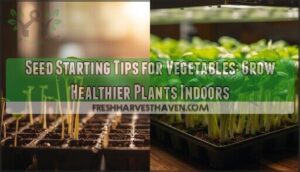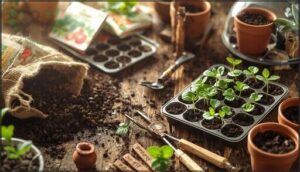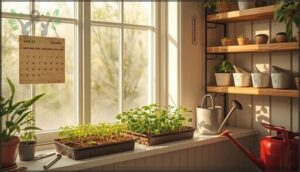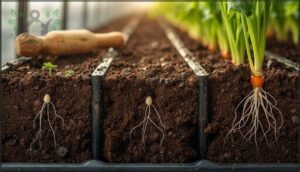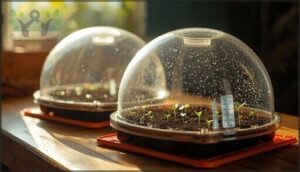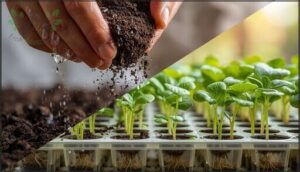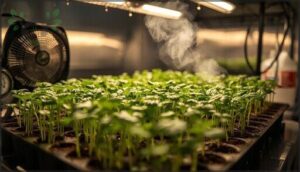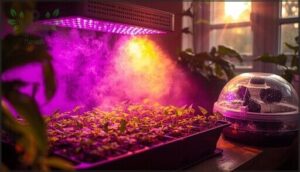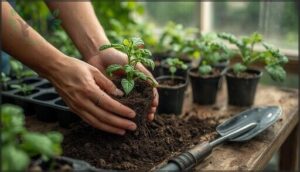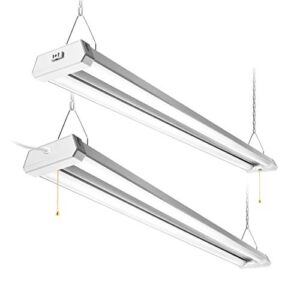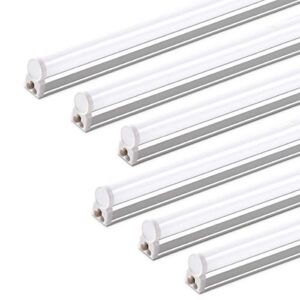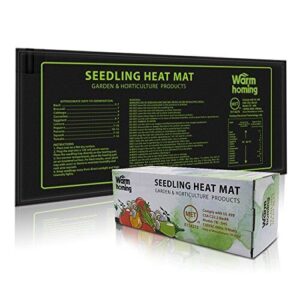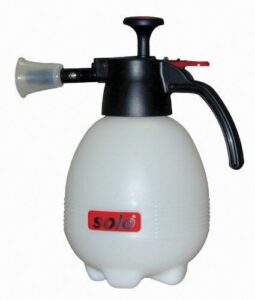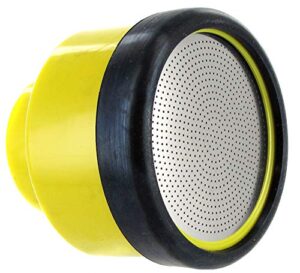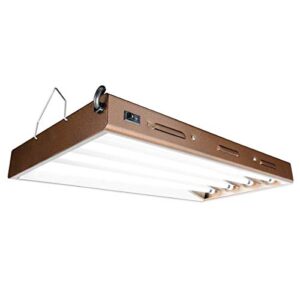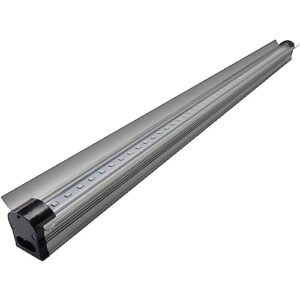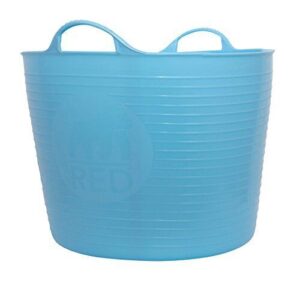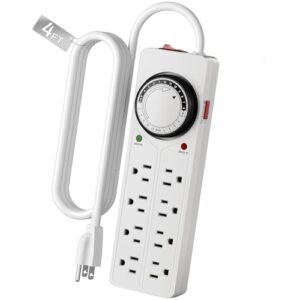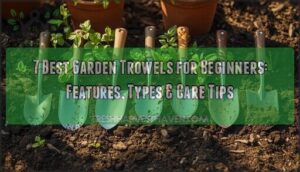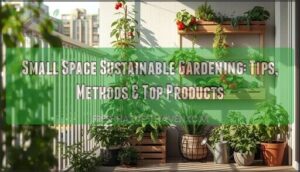This site is supported by our readers. We may earn a commission, at no cost to you, if you purchase through links.
Most gardeners who start seeds indoors make the same mistake: they treat their seedlings like houseplants instead of future crop producers. The difference isn’t just philosophical—it’s the reason some seedlings stretch toward the light like desperate teenagers reaching for their phones, while others develop into stocky, resilient transplants that hit the ground running.
Starting seeds indoors gives you control over timing, variety selection, and growing conditions that simply aren’t possible when you’re at the mercy of local nursery stock or unpredictable spring weather. The technique extends your harvest window by weeks, slashes your per-plant costs to pennies, and opens up a world of heirloom varieties you’ll never find at the garden center.
Master a few core seed starting tips for vegetables—proper lighting distance, temperature management, and watering technique—and you’ll transform those tiny seeds into vigorous plants that outperform anything you could buy.
Table Of Contents
- Key Takeaways
- Essential Benefits of Starting Seeds Indoors
- Choosing Quality Seeds and Supplies
- Step-by-Step Indoor Seed Starting Tips
- Providing Light, Warmth, and Airflow
- Transplanting and Seedling Care Essentials
- Top 9 Tools for Successful Seed Starting
- 1. Bright Led Shop Light Fixture
- 2. Bright White Led Shop Lights
- 3. Seedling Warmth And Growth Mat
- 4. Portable Garden Pressure Sprayer Tool
- 5. Dramm Lemonhead Hose End Sprayer
- 6. High Performance Grow Light Fixture
- 7. Full Spectrum Led Grow Light
- 8. Flexible Large Garden Tub Trug
- 9. Surge Protector Timer Outlet Strip
- Frequently Asked Questions (FAQs)
- How to successfully germinate vegetable seeds?
- Which vegetables should not be planted next to each other?
- Is it better to germinate seeds in soil or paper towel?
- What is the best method for starting seeds?
- Can I reuse seeds from store-bought vegetables?
- What temperature kills seeds during storage?
- How long do different vegetable seeds stay viable?
- Can I start seeds in regular potting soil?
- When should I stop watering before transplanting?
- Can I reuse old seed starting trays safely?
- Conclusion
Key Takeaways
- Starting seeds indoors 4–6 weeks before your last frost extends your growing season by 20–30%, adds up to 40 productive days, and slashes per-plant costs by over 80% compared to nursery transplants while opening access to hundreds of heirloom and specialty varieties you’ll never find at garden centers.
- Position LED grow lights 18–24 inches above seedlings to deliver 100–300 μmol/m²/s for 14–16 hours daily, pair with heat mats to maintain 75–85°F soil temperature for warm-season crops, and use sterile seed starting mix with bottom watering to prevent damping-off disease that can destroy entire trays overnight.
- Plant seeds at 2–3 times their smallest diameter, maintain consistent moisture without waterlogging, run a small fan over trays for air circulation, and transplant only after 2–5 true leaves develop—then harden off seedlings gradually over 7–14 days before moving them outdoors to prevent transplant shock.
- Remove humidity domes immediately after germination to reduce fungal disease risk, dilute liquid fertilizers to 25–50% strength starting at 4–6 true leaves to avoid salt injury, and sterilize reused trays in 10% bleach solution for ten minutes to eliminate pathogens between growing cycles.
Essential Benefits of Starting Seeds Indoors
Starting seeds indoors isn’t just a gardening technique—it’s a strategic advantage that puts you in control of your entire growing season. Whether you’re aiming for earlier harvests, more variety, or simply healthier plants, this approach delivers tangible benefits that transplants from the nursery can’t match.
Here’s why taking the indoor route makes practical sense for your vegetable garden.
Extend Your Vegetable Growing Season
By starting vegetable seeds indoors four to six weeks before your last frost, you’ll gain 20 to 30 percent more productive time—enough for earlier harvests and additional succession plantings. Indoor seed starting effectively shifts your schedule forward by up to 40 days, transforming a 120-day frost-free window into a 150-day season.
Starting seeds indoors four to six weeks early extends your growing season by 20 to 30 percent, adding up to 40 productive days
This season extension matters most where soil temperature and frost protection define your limits. Using techniques like row cover protection can further improve the growth of your plants.
Access to a Wider Variety of Plants
Beyond season length, seed starting opens access to hundreds of vegetable varieties versus the 15 to 20 transplants stocked at most garden centers. You’ll find heirloom varieties, specialty crops, and open-pollinated lines rarely sold as seedlings—genetics that preserve seed diversity and match your exact garden conditions.
A single packet yields 20 to 30 times more plants than buying transplants, letting you experiment broadly with crop selection. This approach allows gardeners to explore seed starting options for a more diverse garden.
Cost Savings and Increased Productivity
Each $4 seed packet starts 15 to 30 plants—reducing your per-plant cost by over 80% compared to nursery transplants. Once you’ve invested in reusable trays, grow lights, and seedling care supplies, marginal costs drop sharply:
- A well-maintained garden offsets roughly $500 in annual produce purchases
- Indoor seed starting shifts harvest windows forward by 2 to 8 weeks
- Earlier transplants increase total crop yield per square foot
- Seed starting mix and DIY methods optimize garden efficiency and financial returns
Healthier, More Resilient Seedlings
When you control indoor conditions, your seedlings develop deeper roots and thicker stems before facing the outdoors. Studies show that 32-day-old sweet corn transplants exceed 26 cm in root length—nearly double that of 12-day-old seedlings—building resilience against pests and disease.
Here’s how seedling age and indoor seed starting techniques shape plant resilience:
| Seedling Advantage | Measurable Outcome |
|---|---|
| Root development | 26.79 cm depth at 32 days |
| Biomass gain | 3.38 g fresh weight |
| Nutrient accumulation | 0.21% nitrogen content |
| Disease resistance | Fewer damping-off losses |
Proper seedling nutrition and germination rates under controlled warmth give you transplants that shrug off early stress, establishing faster and yielding more than direct-sown seed starting mix rivals.
Choosing Quality Seeds and Supplies
Your seed starting success starts with the right foundation. High-quality seeds paired with proper supplies make the difference between weak, struggling seedlings and vigorous plants that thrive from day one.
Let’s walk through what you need to choose and why it matters for your indoor growing setup.
Selecting The Right Vegetable Seed Varieties
Your success with indoor vegetable seed starting hinges on choosing varieties matched to your climate and goals. Disease resistance can slash fungicide use by 40% in some crops, while heat-tolerant varieties extend harvests when temperatures spike.
Focus your seed selection on these key traits:
- Disease resistance – Reduces yield losses by 30–50% under high pressure
- Climate adaptation – Heat tolerance and appropriate maturity dates for your region
- Yield potential – Hybrids often outperform heirlooms, though flavor may vary
Assessing Seed Quality and Viability
Quality vegetable seed starting depends on verifying germination rates before you sow. Test 10 seeds on a damp paper towel for 7–10 days—8 sprouting indicates 80% viability, the baseline for reliable stands. Packets below 70% germination waste effort and space.
| Germination Result | Viability Rating |
|---|---|
| 8–10 seeds sprout | Excellent (80–100%) |
| 6–7 seeds sprout | Marginal (60–70%) |
| Below 6 seeds sprout | Replace seed lot |
Laboratory tests measure seed quality through electrical conductivity and standardized germination protocols using 400+ seeds, but home paper towel tests deliver actionable data fast.
Age matters—onion and parsnip seed decline rapidly after one year, while tomatoes and brassicas stay viable longer under proper seed storage conditions.
Seed Storage and Sourcing Tips
Proper storage conditions dramatically extend seed longevity—aim for temperatures between 35–45°F and keep relative humidity below 40%. The sum of storage temperature (°F) plus relative humidity shouldn’t exceed 100 to maintain viability.
- Store vegetable seeds in screw-top glass jars or sealed containers with desiccant packs
- Refrigerator storage preserves germination rates better than room temperature
- Most seeds stay viable 1–2 years; some last up to 10 years when frozen
- Source certified organic options from reputable suppliers for healthier seed starting
- Save open-pollinated varieties for local adaptation and cost-effective seed selection
Best Seed Starting Mixes and Containers
Your seed starting mix should feel light, drain well, yet hold enough moisture for consistent germination. A blend of 40% sphagnum peat moss, 30% vermiculite, and 20% perlite delivers reliable results—tomato seeds often hit 92% germination in optimized mediums. Avoid garden soil; sterile germination mediums prevent disease and support healthier seedlings.
Soil block making eliminates containers entirely—roots self-prune when exposed to air, preventing transplant shock. For potting soil recipes, add 10% worm castings to boost nutrition. Match container sizes to your crop: smaller cells suit salads and cabbage family vegetables, while 5 cm cells accommodate squash and beans for sturdy root systems.
| Container Type | Best For | Cell Count/Size |
|---|---|---|
| Cell trays (10×20″) | Organized indoor seed starting | 24–48 cells (2.5–5 cm) |
| 4-cell trays | Peppers, tomatoes, beans | Large individual cells |
| Egg cartons | Broccoli, kale, medium seedlings | 12 compartments |
| Soil blocks | Air-pruned roots, pot-less growing | Custom sizes |
| Ceramic pots | Multi-year durability | Varies with drainage |
Step-by-Step Indoor Seed Starting Tips
Starting seeds indoors isn’t complicated, but getting the details right makes all the difference between strong seedlings and weak ones. You’ll need to pay attention to timing, moisture levels, and temperature from the moment you sow your first seed.
The following techniques will help you establish healthy seedlings that thrive from germination through transplanting.
Optimal Timing for Starting Vegetable Seeds
Timing is everything when you’re working with indoor seed starting—plant too early and seedlings outgrow their containers, too late and your harvest window shrinks. Your seed starting calendar should anchor to your last frost date, with cool-season brassicas begun 10–12 weeks before and warm-season crops like tomatoes started 6–8 weeks prior.
Climate considerations and soil temperature ultimately determine when seedlings can safely move outdoors.
Sowing Seeds at The Correct Depth
Getting the depth right makes all the difference between vigorous emergence and disappointing germination rates. Apply these seed depth guidelines when working with your seed starting mix:
- Fine seeds (lettuce, basil): Cover with 1–3 mm of mix to maintain soil moisture without blocking light-dependent germination
- Medium seeds (carrots, brassicas): Sow 6–12 mm deep for reliable seedling care and emergence rates
- Large seeds (peas, beans): Place 25–50 mm deep to prevent desiccation during seed germination
- General rule: Plant at two to three times the seed’s smallest diameter for ideal depths across most vegetables
Measure with marked dibbers to guarantee consistent indoor seed starting and uniform sowing techniques throughout your trays.
Using Heat Mats and Humidity Domes
Heat mats raise your seed starting mix by 10–20°F above room temperature, accelerating seed germination for warm-season vegetables like tomatoes and peppers that thrive around 80–85°F.
Pair your heat mat with a humidity dome to maintain near-saturated air moisture during indoor seed starting, but remove the dome once seedlings emerge—stagnant conditions invite damping-off disease.
Temperature regulation and proper dome ventilation protect your emerging seedlings from fungal threats while ensuring reliable humidity control.
Pre-moistening and Watering Techniques
Before you fill your trays, hydrate your seed starting mix thoroughly until it clumps when squeezed but doesn’t drip—this pre-moistening prevents dry pockets that repel water later.
Once seedlings emerge, switch to bottom watering by filling the outer tray and letting moisture rise through drainage holes, which encourages deeper root growth while keeping foliage dry and reducing disease risk from poor water quality or salinity effects on tender indoor seed starting.
Preventing Damping Off and Common Issues
Proper watering lays the groundwork, but vigilant sanitation methods and air circulation techniques make damping off control achievable. Sterilize reused trays in a 10% bleach solution for ten minutes to eliminate pathogens, then use pasteurized seed starting mixes—never garden soil—which harbor fewer diseases. Bottom heat around 70–75°F accelerates indoor seed starting by shortening the vulnerable window when seedlings are most susceptible to collapse.
Seedling care and maintenance requires:
- Thin crowded seedlings immediately so air moves freely around stems, drying surfaces that fuel infection
- Remove any flat showing damping off at first sign—those diseased containers spread trouble fast
- Run a small fan gently over trays to drop humidity and toughen tender tissue against fungal attack
Providing Light, Warmth, and Airflow
Once your seeds are in their containers, they’ll need the right environment to germinate and grow into sturdy seedlings. Light, temperature, and air circulation work together to prevent weak, leggy plants and common problems like damping off.
Let’s look at how to set up each element for the healthiest start possible.
Choosing and Using Grow Lights Effectively
You’ll want LED grow lights positioned 18–24 inches above your seedling trays to deliver ideal PPFD levels of 100–300 μmol/m²/s once established. Modern LEDs offer 44% better efficiency than fluorescents while providing the full light spectrum your seedlings crave.
Set timers for 14–16 hour photoperiods to prevent stretching, and adjust fixture height weekly as plants grow—this attention to grow light placement transforms indoor gardening success.
Maintaining Ideal Temperature for Germination
Your seeds need consistent warmth to germinate quickly and uniformly—most warm-season vegetables like tomatoes and peppers thrive at 75–85°F, while cool-season crops prefer 50–70°F. Heat mats raise root-zone temperature by 10–20°F above ambient conditions, accelerating emergence when paired with soil thermometers for precise monitoring.
- Position heat mats beneath waterproof trays to deliver steady bottom warmth
- Insert soil thermometers 1 inch deep to verify you’re hitting ideal ranges
- Remove heat sources once seedlings emerge to prevent overheating stress
- Target 85°F for peppers and eggplant, 70–75°F for lettuce and spinach
Ensuring Proper Air Circulation and Humidity Control
Without adequate ventilation systems, high humidity traps moisture around your seedlings and invites damping-off fungi that can wipe out entire trays overnight. Position an oscillating fan to sweep air across the canopy at 0.5–1.0 meters per second, then remove humidity domes once sprouts appear.
These indoor gardening methods keep relative humidity between 50–70 percent, ensuring microclimate management that prevents disease while your seedlings breathe freely.
Transplanting and Seedling Care Essentials
Once your seedlings have developed their first set of true leaves, they’ll need proper care to shift from the protected indoor environment to the garden. This stage requires careful attention to transplanting techniques, gradual outdoor exposure, and appropriate nutrition to keep young plants thriving.
Understanding these essentials will help you avoid common pitfalls like transplant shock, nutrient deficiencies, and pest damage as your seedlings mature.
When and How to Transplant Seedlings
Knowing when your seedlings are ready separates confident gardeners from those who rush. Transplant most vegetables when they’ve developed 2–5 true leaves, usually around 2–4 weeks for cucumbers and squash. Tomatoes need 6–8 weeks for proper root development.
Move seedlings into larger 2–3 inch containers once crowding begins, preventing root-bound stress that weakens post-transplant vigor and delays outdoor acclimation.
Hardening Off for Outdoor Planting
Hardening off transforms fragile seedlings into resilient transplants ready for outdoor conditions. Begin acclimation techniques 7–14 days before transplanting, starting with 2–3 hours of outdoor exposure in shade.
Gradually increase sunlight and duration daily while maintaining temperature management above 45°F for cool-season crops and 60°F for warm-season vegetables.
Wind protection remains essential—use sheltered locations initially, then introduce gentle breezes to strengthen stems and boost seedling resilience.
Fertilizing Young Seedlings Safely
Young seedlings are more vulnerable to fertilizer burn than mature plants—their immature root systems can’t handle concentrated nutrients. Start feeding only after 4–6 true leaves emerge, using liquid fertilizers diluted to half strength once or twice weekly.
- Begin fertilization 1–2 weeks post-germination in soilless mixes
- Use balanced NPK ratios (1–1–1 or 1–2–1) for steady development
- Dilute to 25–50% of label strength to prevent salt injury
- Apply until 10–20% drains from containers, flushing excess salts
- Choose organic fertilizers for gentler, slower nutrient release
Managing Seedling Pests and Diseases
Even under ideal conditions, fungus gnats and damping-off pathogens can devastate your seedling trays. Allow the top half-inch of mix to dry between waterings—fungus gnat larvae thrive in saturated media and can stunt roots within days.
Use yellow sticky cards for fungus gnat control, and apply Bacillus subtilis biocontrol products for damping-off prevention.
Good seedling sanitation and airflow reduce disease pressure better than any organic fungicides.
Top 9 Tools for Successful Seed Starting
The right equipment can make the difference between weak, leggy seedlings and vigorous plants ready to thrive in your garden. You don’t need an elaborate setup, but investing in a few essential tools will simplify your seed starting process and improve your success rate.
Here are nine reliable tools that will help you grow healthier vegetable seedlings from the start.
1. Bright Led Shop Light Fixture
You’ll want a bright LED light fixture that delivers around 4,000 to 5,000 lumens for seed starting—enough intensity to support healthy seedling growth rates without breaking the bank. These lighting fixture options usually provide a 5,000K daylight spectrum, which encourages compact indoor sowing and strong early development.
Position your LED about 15 to 30 cm above trays for ideal grow light intensity.
Energy efficiency tips matter here: modern LEDs consume roughly 30 to 40 percent less power than fluorescent alternatives while producing less heat, making them ideal for seedlings.
Best For: Home gardeners and hobbyists who want an affordable, energy-efficient lighting solution for starting vegetable seedlings indoors without investing in specialized horticultural fixtures.
- Delivers 4,200 lumens at 5000K daylight spectrum, providing sufficient intensity and spectral quality to support compact vegetative growth when positioned 15 to 30 cm above seedling trays.
- Uses roughly 30 to 40 percent less power than comparable fluorescent shop lights while producing significantly less heat (about 136 BTU/hour versus 290 BTU/hour), reducing cooling needs and allowing safer close placement above delicate seedlings.
- Linkable design and included hanging chain make it easy to daisy-chain multiple units across seed-starting shelves, with each 4 ft fixture covering approximately 0.4 to 0.6 m² and a rated lifespan exceeding 30,000 hours for years of reliable use.
- LED tubes are integrated and non-replaceable, meaning the entire fixture must be discarded when the LEDs eventually fail rather than simply swapping out bulbs.
- Thin metal construction may feel less durable than heavier commercial-grade fixtures, and some users report inaccessible mounting holes that complicate flush ceiling installation.
- May require additional extension cords for flexible positioning, and the fixture can experience a slight lag when powering on in very cold temperatures during winter seed-starting sessions.
2. Bright White Led Shop Lights
When comparing Indoor Lighting Solutions, you’ll notice that bright white LED shop lights—like the Barrina 6500K fixtures delivering 2,200 lumens each—offer a more complete Led Light Spectrum across blue, green, and red wavelengths. This daylight-quality emission encourages Seedling Growth Tips by reducing legginess and promoting compact foliage.
Energy Efficient Options like these 20W Plant Lighting Systems consume far less electricity than older fluorescents while running cooler, which protects delicate seedlings during Indoor Sowing. Position multiple units 15 to 30 cm above trays for uniform coverage and vigorous Seed Starting success.
Best For: Home gardeners and indoor growers who need affordable, high-output lighting to start seedlings or illuminate workspaces without running up their electricity bill.
- Super bright at 2,200 lumens per fixture with a 6500K daylight spectrum that mimics natural sun, promoting compact seedling growth and reducing stretching
- Energy-efficient design uses only 20W per light while delivering the brightness of much larger fluorescent setups, cutting power costs by up to 85%
- Easy linkable installation lets you connect up to 8 fixtures together and adjust height above your seed trays for optimal coverage
- Short cord length may require extension cords or adapters depending on your setup
- Not dimmable, so you can’t fine-tune intensity without changing the fixture height
- Some users report concerns about long-term durability compared to previous models
3. Seedling Warmth And Growth Mat
Bright lighting alone won’t bring seeds to life if Soil Temperature lags behind. A well-designed Heat Mat raises the root zone 10 to 20°F above ambient air, pushing Germination Rates toward 90 percent for tomatoes and peppers when you maintain 75 to 85°F.
Position your Growth Mats under standard trays, monitor with a soil probe, and remove Seedling Heat once sprouts emerge—extended warmth invites stress and disease.
Pair Mat Maintenance with timely checks to avoid overheating, ensuring your Indoor Growing setup delivers uniform, vigorous seedlings every season.
Best For: Indoor gardeners starting warm-season vegetables like tomatoes and peppers who need consistent bottom heat to boost germination rates in cool rooms.
- Raises soil temperature 10 to 20°F above room temp, hitting the sweet spot of 75 to 85°F that pushes germination rates toward 90 percent for heat-loving seeds.
- UL-listed and waterproof design with stronger heating wire means you get safer, more durable performance compared to older models.
- Low 15W power draw keeps operating costs around 30 cents per month even with daily use, making it budget-friendly for small-scale propagation.
- Can overheat if left on too long without a thermostat, creating fire risk and potentially cooking your seeds instead of warming them.
- Compact 18.5″ x 8.5″ size only fits one standard tray, so you’ll need multiple mats for larger seed-starting operations.
- Some users report inconsistent heat output or minimal temperature increase, meaning performance can be hit-or-miss depending on your room conditions.
4. Portable Garden Pressure Sprayer Tool
Keeping Seedlings hydrated without washing away delicate Seed Starting mix calls for precise Pressure Control—a handheld Garden Sprayer delivers exactly that. Adjust your nozzle to mist droplets below 150 microns, which lands gently on leaf surfaces while minimizing runoff and supporting Water Conservation across your Indoor Gardening setup.
Before each Seedling Care session, run a quick Sprayer Calibration by measuring output over a known area to match diluted fertilizer rates accurately. This Gardening Tip ensures uniform coverage, reduces disease hot spots, and protects young plants from salt stress—giving you mastery over every drop.
Best For: Home gardeners and greenhouse enthusiasts who need precise, gentle watering for seedlings and small plants.
- Adjustable nozzle lets you control spray pattern for misting or direct streams.
- Lightweight, ergonomic design reduces hand fatigue during use.
- Integrated pressure release valve adds safety and prevents over-pressurizing.
- Can feel a bit heavier than expected when full.
- Not ideal for covering very large areas or heavy-duty tasks.
- Requires occasional pumping to maintain consistent pressure.
5. Dramm Lemonhead Hose End Sprayer
A soft flow beats a hard stream when you’re protecting tender root systems—the Dramm Lemonhead disperses approximately 750 micro-holes into a gentle spray that won’t disturb Seed Starting media or expose fragile Seedlings to mechanical damage.
At 7 GPM flow and 40 PSI, you’ll cover multiple trays quickly while maintaining consistent Soil Moisture across benches.
This lightweight Hose End Sprayer integrates seamlessly into your Watering Techniques, reducing splash-borne disease and improving uniformity in your Vegetable Gardening setup—essential Gardening Tools for confident Seedling Care every session.
Best For: Greenhouse operators and home gardeners who need to water seed trays, seedling flats, and young transplants without disturbing delicate roots or washing away soil.
- 750 micro-holes create a soft, dispersed spray that protects fragile seedlings and prevents soil displacement during watering
- Lightweight design at 1.6 ounces reduces hand fatigue during extended watering sessions across multiple benches or beds
- 7-8 GPM flow rate at 40 PSI delivers quick coverage while using 56% less water than higher-flow models, making it efficient for targeted irrigation
- Plastic construction may not hold up as well as metal alternatives under heavy commercial use or rough handling
- 50 PSI maximum pressure limit restricts use with higher-pressure water systems or situations requiring stronger flow
- Fine spray holes can clog over time if water contains sediment, requiring periodic cleaning or an inline filter
6. High Performance Grow Light Fixture
Four 6400K T5 tubes deliver 8,000 lumens across a 23-inch footprint—that’s the Light Spectrum intensity your Seedlings need for stocky Indoor Gardening success.
This High Performance Grow Light Fixture combines textured steel with faceted aluminum reflectors to distribute photons evenly, preventing leggy Seedling Growth even when mounted vertically.
At 60Hz frequency and with a daisy-chainable design, you’ll scale coverage across benches without overloading circuits.
For Gardening for Beginners tackling Seed Starting Tips, this Fixture Design proves LED Efficiency meets reliable T5 output every season.
Best For: Indoor gardeners running seed starting operations or vegetable propagation setups who need reliable, high-lumen fluorescent coverage across multiple trays without complicated installation.
- 8,000 lumens from four 6400K T5 tubes provide strong blue-spectrum light that keeps seedlings compact and prevents stretching across a 23-inch footprint.
- Daisy-chain capability and dual mounting options (overhead or vertical) let you expand coverage across benches or shelving racks without rewiring circuits.
- Faceted aluminum reflectors maximize light distribution and reduce hotspots, so you get even coverage from edge to edge on standard 1020 trays.
- T5 fluorescent technology generates more heat than modern LEDs, so you’ll need adequate ventilation to prevent temperature spikes in enclosed growing spaces.
- Ballast durability issues reported by some users mean you might face replacement costs or downtime during critical growing cycles.
- Bulbs require periodic replacement as lumen output degrades over time, adding ongoing maintenance compared to long-life LED alternatives.
7. Full Spectrum Led Grow Light
Spectrum Lighting from 400–700 nm PAR delivers the blue peaks your seedlings crave for compact growth and red wavelengths that accelerate chlorophyll production—Seed Starting Tips rooted in photobiology.
These Led Grow Options position 18–24 inches above trays to achieve 200–300 μmol/m²/s, the sweet spot where biomass jumps 39–96 percent compared to fluorescent Indoor Plant Lighting.
Grow Light Systems consuming just 48 watts run 50,000 hours while cutting energy costs by half, making Led Panel Benefits undeniable for serious Indoor Gardening success every season.
Best For: Home growers starting seeds indoors or raising seedlings in small-to-medium spaces who want energy-efficient, full-spectrum light without the heat buildup of traditional fixtures.
- Delivers 200–300 μmol/m²/s at the ideal 18–24 inch height, boosting seedling biomass by up to 96% compared to fluorescents while doubling soluble protein and vitamin C content.
- Uses half the electricity of older grow lights and runs for 50,000 hours, saving hundreds annually on power and replacement costs.
- Self-cooling design keeps heat minimal, and you can link up to 8 units on one cord for easy expansion across multiple trays.
- The 90-degree beam angle may leave gaps as plants spread out, requiring you to add more fixtures or reposition frequently.
- Some buyers report inconsistent longevity depending on the seller, so sticking with reputable vendors matters more than the spec sheet suggests.
- 48 watts works well for seedlings but won’t support larger, high-light plants like fruiting tomatoes once they outgrow the starter phase.
8. Flexible Large Garden Tub Trug
You’ll mix enough potting medium for thirty flats in a ten-gallon Tub Trug that flexes when you pour, making Seedling Transport and Flexible Gardening simple while mastering Seed Starting. The phthalate-free sides squeeze inward to funnel mix directly into cells—Seed Starting Tips that eliminate spills during Indoor Gardening workflows.
UV-resistant grips carry wet soil or multiple trays between germination stations without strain, and stackable nesting solves Garden Tool Storage challenges in tight quarters.
Tub Maintenance demands only a rinse between batches, preventing disease carryover across your Seedlings while Gardening Tips emphasize durability through frost and sun.
Best For: Home gardeners who need a lightweight, durable container for mixing seed-starting media, transporting seedling trays, and handling multiple planting tasks without worrying about spills or storage space.
- Flexible sides squeeze inward to pour potting mix directly into seed cells or flats without making a mess, saving cleanup time during repetitive sowing tasks.
- UV-resistant and frost-proof construction means you can leave it outdoors through all seasons without cracking, fading, or losing strength.
- Lightweight at just over a pound but holds 10 gallons, so you can carry heavy wet soil or multiple trays using the comfort-grip handles without straining your hands or back.
- The price point runs higher than basic plastic buckets, which some buyers find steep for what is essentially a flexible tub.
- Light colors like sky blue show dirt and stains easily, requiring more frequent washing to keep it looking clean in a busy garden workspace.
- The large logo printed on the side can look cheap or tacky, which bothers people who prefer plain, professional-looking garden tools.
9. Surge Protector Timer Outlet Strip
An eight-outlet surge protector with a mechanical timer gives you precision power management for seed-starting light schedules. Four timer settings outlets cycle your grow fixtures through sixteen-hour photoperiods, while four always-on receptacles run fans continuously.
Energy efficiency improves when you automate indoor gardening routines instead of guessing runtimes, and integrated surge protection guards LED drivers against voltage spikes that damage sensitive circuits.
This outlet configuration keeps heat mats and seedlings under controlled conditions, letting you focus on seed-starting tips rather than manual switching every dawn and dusk.
Best For: Indoor gardeners and seed-starting enthusiasts who need automated light schedules for seedlings, heat mats, and grow lights while protecting equipment from power surges.
- Four timer-controlled outlets automate 16-hour photoperiods for grow lights while four always-on outlets keep fans and monitors running continuously, eliminating manual switching.
- Handles up to 1,875 watts safely, so you can run multiple LED fixtures and heat mats (typically 240–400 watts total for home setups) with plenty of capacity left over.
- Built-in surge protection guards sensitive LED drivers and electronic components from voltage spikes that could damage your lighting investment.
- Multiple user reports indicate the timer mechanism stops working or produces loud buzzing sounds within weeks of use, suggesting reliability problems.
- The 3-foot power cord is too short for many grow-room setups, limiting placement options and forcing users to position equipment closer to wall outlets.
- Quality control issues mean some units arrive smaller or cheaper than expected, and durability concerns show devices breaking down within a month of regular operation.
Frequently Asked Questions (FAQs)
How to successfully germinate vegetable seeds?
To successfully germinate vegetable seeds, maintain ideal soil temperature between 65-85°F, use sterile germination mix, plant at proper depth (2-3 times seed diameter), and provide consistent moisture while ensuring good air circulation.
Which vegetables should not be planted next to each other?
You might think all vegetables coexist peacefully, but companion planting matters. Tomatoes and potatoes risk blight transmission, beans struggle near onions through growth suppression, and fennel inhibits most crops, demanding thoughtful garden layout for ideal plant growth.
Is it better to germinate seeds in soil or paper towel?
Both methods work, but soil germination offers less transplant shock and simpler handling.
Paper towel methods excel for testing seed viability or accelerating slow-germinating varieties, though delicate root systems require careful transfer to avoid damage.
What is the best method for starting seeds?
The best method balances a sterile soilless mix in well-drained containers, consistent moisture through bottom watering, heat mats for 70–80°F germination temperatures, and bright LED lights positioned inches above emerging seedlings for stocky growth.
Can I reuse seeds from store-bought vegetables?
You can, but proceed with caution. Most grocery vegetables come from hybrids with unpredictable traits, carry potential disease risks, and may involve intellectual property restrictions.
Certified seed packets offer far more reliable germination and genetic consistency.
What temperature kills seeds during storage?
Think of seeds as fragile living embers—too much heat snuffs them out. Temperatures above 108°F during storage kill vegetable seeds outright, while consistent exposure over 90°F gradually destroys viability and germination potential.
How long do different vegetable seeds stay viable?
Most vegetable seeds remain viable for three to five years under cool, dry storage conditions. Onions and leeks decline after one year, while cucumbers and melons can last five years or more.
Can I start seeds in regular potting soil?
You can start seeds in regular potting soil, but specialized seed starting mix delivers excellent germination rates.
Its fine texture matters immensely—sterile, lightweight formulations prevent damping off while promoting vigorous seedling development through ideal aeration and moisture balance.
When should I stop watering before transplanting?
You should reduce watering frequency during hardening off—about seven to ten days before transplanting.
This gradual water reduction strengthens roots and readies seedlings for outdoor conditions, minimizing transplant shock while maintaining adequate soil moisture.
Can I reuse old seed starting trays safely?
Like a well-worn garden tool, old trays can serve you again—but only after thorough tray sanitation.
Disease prevention demands cleaning methods that eliminate pathogens: scrub with soapy water, then soak in a 10% bleach solution for proper seedling safety.
Conclusion
Think of your seed starting setup as a launching pad—every adjustment you make either propels your seedlings toward vigorous growth or leaves them struggling at liftoff.
These seed starting tips for vegetables give you the technical precision to cultivate transplants that don’t just survive the garden—they dominate it.
Master the fundamentals of light, temperature, and moisture, and you’ll never settle for weak nursery stock again. Your best harvests begin here.
- https://harvesttotable.com/vegetable-seed-germination-special-requirements/
- https://extension.psu.edu/seed-and-seedling-biology
- https://www.aces.edu/blog/topics/lawn-garden/soil-temperature-conditions-for-vegetable-seed-germination/
- https://extension.msstate.edu/publications/damping-vegetables
- https://www.gorillagrowtent.com/blogs/news/ppfd-for-seedlings

